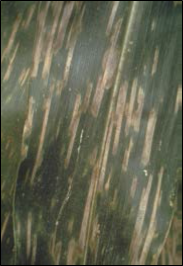Gray Leaf Spot in Corn
Gray Leaf Spot
Symptoms
Early foliar symptoms of gray leaf spot appear as pinpoint olive-green spots about 1/16 inch in size. These develop

Gray Leaf Spot
Paul Vincelli, University of KY
into slightly elongated, roughly parallel-sided lesions with a yellow halo. Halos can best be seen by holding an infected leaf up to the light.
After about two weeks these symptoms become mature rectangular lesions characteristic of gray leaf spot. Lesions are tan to gray, 3/4 to 2-1/2 inches long by 1/8 to 1/4 inches wide and run parallel to the leaf veins. Under heavy disease pressure, entire leaves may be blighted. Unlike many other corn foliar diseases, gray leaf spot lesions will remain evident on completely blighted leaves, even at maturity. Severely affected leaves will have a grayish cast because the lesions produce so many spores of the fungus.
Gray leaf spot develops first on lower leaves and may spread upward to the highest leaf. Regardless of planting date, initial symptoms of gray leaf spot generally will not appear until anthesis.
Cause
Gray leaf spot is caused by the fungus Cercospora zeae-maydis. Corn is the only crop know to be attacked by this fungus. The fungus survives the winter in undecomposed corn residue. The fungus will usually survive for no more than two years; often, one year away from corn allows for substantial reduction in risk. When infested residue is buried during tillage operations, fungus survival is greatly reduced. The risk of gray leaf epidemics is greatest in no-till fields where corn is grown without rotation.
In early summer the fungus within the infested debris produces spores which are carried by the wind to the new corn crop. Infections occur during repeated, prolonged periods (11-13 hours) of leaf wetness and high humidity (>95%). Moist conditions and daily temperatures of 70-85 degrees F are ideal for gray leaf spot to develop.
IPM Techniques
- Plants should be examined for gray leaf spot every two weeks from tasseling to maturity.
- Observe two rows of plants 10 feet in length at several representative locations. The number of random sites you should observe when scouting a field is based on the size of the field. To determine the number of scouting sites see Scouting Corn.
- Report the severity of the disease according to the following rating scale:
0 = no symptoms;
1 = a few lesions on lower leaves of some plants
2 = nearly all plants have some lesions and lesions are not confined to only lower leaves;
3 = all plants have lesions on nearly all leaves, some or all leaves dried up and killed.
- Plant hybrids with partial resistance, especially when grown without rotation under reduced tillage.
- Rotate away from corn for 1 - 2 years.
References and Additional Information
- IPM-2 Kentucky IPM Manual for Corn
- PPA-10a Kentucky Plant Disease Management Guide for Corn and Sorghum by P. Vincelli and D.E. Hershman, Extension Plant Pathologists, University of Kentucky
- PPA-35 Gray Leaf Spot of Corn by Paul Vincelli and Donald E. Hershman, Extension Plant Pathologists, University of Kentucky
- Annual Kentucky Hybrid Corn Performance Test, Progress Report 345, University of Kentucky
Compendium of Corn Diseases. M.C. Shurtleff. The Amer. Phytopathol. Soc. 1980


